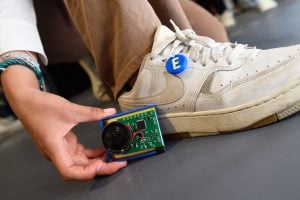
A team of Johns Hopkins electrical and computer engineering students has created a device that hopes to enhance personal security and safety everywhere, from campus walkways to city streets. Chirp Charm, a hands-free alarm worn discreetly on top of a shoe, is designed to be intuitive and easy to activate in an emergency.
Students Nidhi Batra, Eric Ji, Emma Dionne, Thaissa Peixoto, and Lauren Phillips presented their prototype on April 29 at the Whiting School of Engineering’s Design Day, an annual event that showcases student solutions to real-world problems. Their device won both the General Ventures 1 Award and Hopstone Capital Award.
“The inspiration for the name came from Baltimore’s nickname, Charm City, and the growing popularity of charms as fashion statements on shoes,” says Dionne. “‘Chirp’ nods to the device’s alarm sound and the university’s Blue Jay mascot.”
The device is powered by piezoelectric energy generated through walking or other movement, minimizing the need for frequent charging and increasing reliability in critical moments.

When activated by a vigorous stomp, the alarm emits a distinct sound that reaches up to 100 decibels—about the volume of a car horn or your average rock concert.
“Its purpose is to draw attention quickly and potentially deter an attacker,” says Phillips.
The device attaches to the top of a shoe using two lace holes, with a thin piezo pad resting inside. A strong stomp or kick activates a “Listening” mode, indicated by a haptic vibration, turning the safety off to arm the device. If a second stomp occurs within 10 seconds, a 104-decibel alarm is triggered; otherwise, the device resets automatically.
“Most of the students we interviewed expressed a fear of misfiring the alarm, which is why we implemented this feature,” Dionne remarked. A small side button on the external charm allows users to exit Listening mode or silence the alarm at any time, whether the initial stomp was accidental or the user no longer feels at risk.
“We chose a stomp because it reflects a natural panic response,” explains Peixoto. “The motion sensors in the device detect this specific foot movement as opposed to running or jumping, ensuring the alarm activates only when needed.”
The team faced several technical hurdles as they developed the device. Early piezoelectric components failed to produce consistent energy, leading to a switch to specialized energy-harvesting models. The stomp-based trigger also required careful calibration to balance usability and efficiency.
Speaker selection posed another challenge.
“We experimented with various models and are now working on a custom acoustic case to boost the alarm’s volume,” says Batra. “We also created a distinct siren sound that stands out from typical alarms.”
Ultimately, the project reflects a thoughtful blend of engineering and user-centered design.
“Our goal was to create something subtle but powerful,” says Ji. “Whether you’re walking through a busy city or traveling alone, safety should never be a burden, and with two simple stops, it doesn’t have to.”